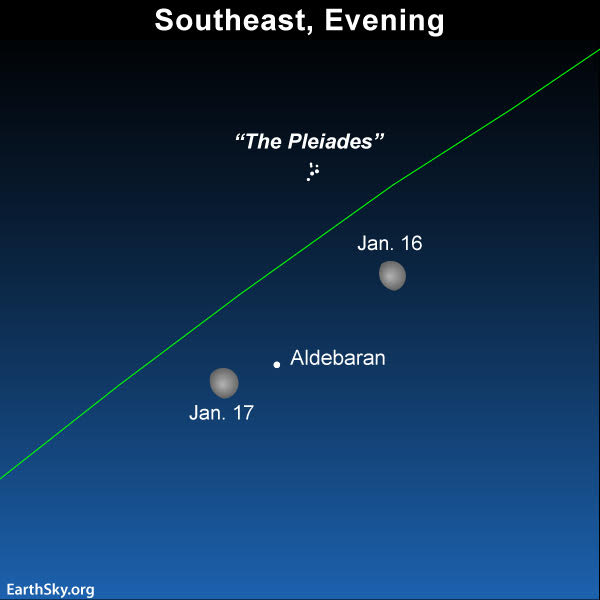Moon near Aldebaran January 16 and 17
Bruce McClure in TONIGHT | January 16, 2019
On January 16 and 17, 2019, the waxing gibbous moon passes in the vicinity of Aldebaran, an ex-pole star, a famous zodiac star and the brightest star in the constellation Taurus the Bull.
This is a wonderful time to learn to identify this star, even though you might have to squint a bit to see it in the moon’s glare.
Aldebaran is a bright reddish star, a good star to come to know. Did you know that Aldebaran is also a former pole star? It’s true, and it’s a fascinating story.
Many people know that Polaris is the present-day North Star, but few know that Aldebaran reigned as the North Star some 450,000 years ago.
What’s more, Aldebaran appeared several times brighter in the sky then than it does now. Plus – 450,000 years ago – Aldebaran shone very close to the very bright star Capella on the sky’s dome. In that distant past, these two brilliant stars served as a double pole star in the astronomical year -447,890 (447,891 B.C.).
At this point, we should probably insert a note about astronomical dating. In ancient times, there was no zero year, so the year A.D. 1 followed the year 1 B.C. However, present-day astronomical calculating is made simpler by equating the astronomical year 0 with the year 1 B.C. Thus, the astronomical year -1 corresponds to 2 B.C. and the astronomical year -2 corresponds to 3 B.C. And so on …
But back to Aldebaran and Capella as dual pole stars. The identity of the pole star shifts over time, due to the 26,000-year cycle of precession.
Still, how can it be, you might wonder, that the stars Aldebaran and Capella were once so near each other on the sky’s dome? They’re not especially close together now. Aren’t the stars essentially fixed relative to one another? The answer is that, yes, on the scale of a human lifespan, the stars are essentially fixed. But the stars are actually moving through space, in orbit around the center of the galaxy. In our solar system, galaxy, and universe … everything is always moving. So the sky looked different hundreds of thousands of years ago than it does today.
So watch for Aldebaran near the moon tonight, and think back to 450,000 years ago, when Aldebaran and Capella teamed up together to serve as Earth’s double north pole star!*
*Source: Page 363 of Mathematical Astronomy Morsels V by Jean Meeus
Bottom line: Will you see Aldebaran in the moon’s glare on January 16 or 17, 2019? Plus … the story of Aldebaran when it was part of a double pole star.
 |
 |
|
|||||||||||
 |
 |
||||||||||||
|
|
|
|
|
|
|
||||||||
 |
|
|
|
|
|
 |
|||||||
|
|
|
|
|||||||||||
|
|
|||||||||||||
|
|
|
|
|
|
|
|
|
|
|
|
|
|
|
Results 1 to 1 of 1
Thread: Moon near Aldebaran
-
01-16-2019, 01:15 PM #1
Moon near Aldebaran
Beginner's Guide for Rocket, NFPS and IKS66...
http://iptvtalk.net/showthread.php?2...-you-should-do
Kodi Options for Rocket, NFPS and IKS66...
http://iptvtalk.net/forumdisplay.php?71-Kodi
Check the Announcement Section...
http://iptvtalk.net/forumdisplay.php...-Announcements
Similar Threads
-
Moon and Regulus
By ilan in forum Maps to the StarsReplies: 0Last Post: 12-16-2019, 01:57 PM -
Lost on the Moon
By ilan in forum The Universe Closer to HomeReplies: 0Last Post: 06-23-2019, 12:36 PM -
Eclipsed Moon & More
By ilan in forum Maps to the StarsReplies: 0Last Post: 12-31-2018, 01:09 PM -
Moon and Venus
By ilan in forum Maps to the StarsReplies: 0Last Post: 11-03-2018, 12:58 PM -
Red Moon
By Marley in forum The Universe Closer to HomeReplies: 18Last Post: 09-28-2015, 04:37 AM








 Reply With Quote
Reply With Quote